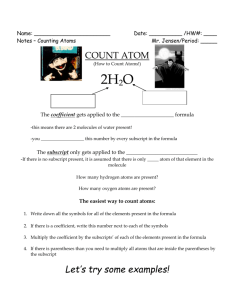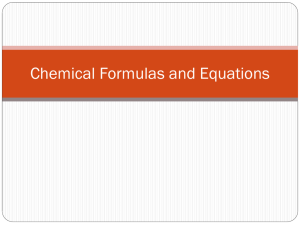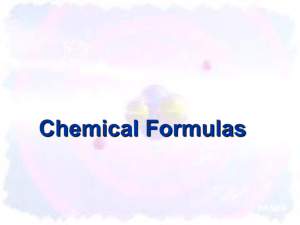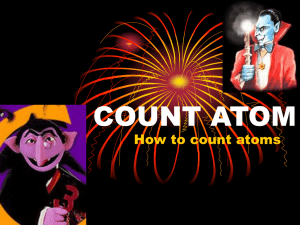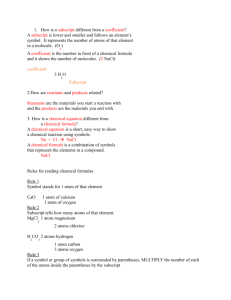17-2 Describing Chemical Reactions
advertisement
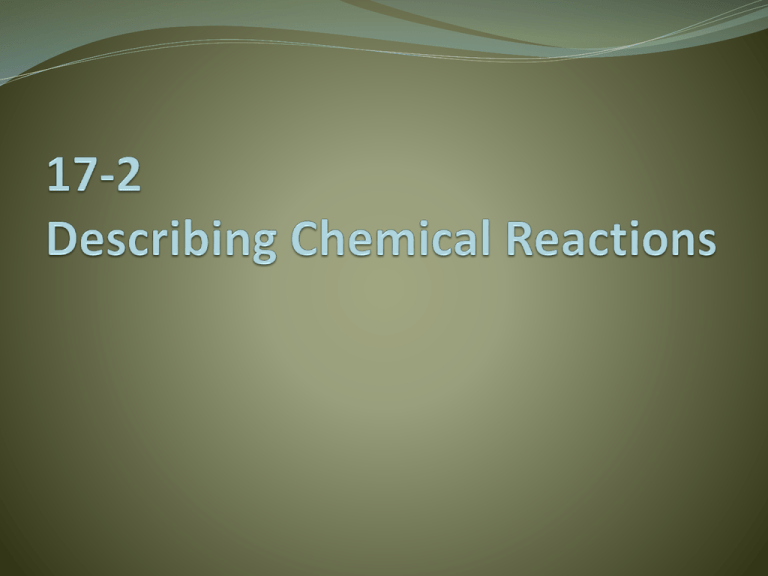
a shorter, easier way to show chemical reactions, using symbols, not words, for the reactants and the products hydrogen molecules react with oxygen molecules to form water molecules H2 + O2 H2O reactant + reactant “YIELDS” products total mass of reactants must equal total mass of products matter is NOT destroyed or created in a chemical reaction = ELEMENTS – represented by a one or two-letter symbol (letter) C Na H COMPOUNDS– represented by a chemical formula (word) which uses subscripts to show the ratio of elements in the compound H2O2 CO2 C3H8O HOW MANY? coefficient in front of the chemical formula tells “how many” atoms or molecules 3H2O2 4CO2 2C3H8O • Add the subscript “2” to all diatomics that are ALONE in the equation (N, O, F, Cl, Br, I, H) (note: only time a subscript can & must be changed) • Count the number of atoms that are present in the basic equation and record • Pick an element that is not balanced on both sides of the equation ( H & O last) • Add a coefficient in front of the chemical formula to adjust the count and record the new values • Continue adding coefficients to obtain the same number of atoms of each element on both sides of the equation (change coefficient, then change counts) H + O H2O • Add the subscript “2” to all diatomics that are ALONE in the equation (N, O, F, Cl, Br, I, H) Mg + O MgO (note: only time a subscript can & must be changed) • Count the number of atoms that are present in the basic equation and record • Pick an element that is not balanced on both sides of the equation ( H & O last) • Add a coefficient in front of the chemical formula to adjust the count and record the new values • Continue adding coefficients to obtain the same number of atoms of each element on both sides of the equation (change coefficient, then change counts) C + Cl CCl4 Mg C + + O2 Cl2 ------> ------> MgO CCl4 Al + O2 Al2O3 Note: add like elements on the same side of the equation SO2 + O2 SO3 • Add the subscript “2” to all diatomics that are ALONE in the equation (N, O, F, Cl, Br, I, H) Al + O Al2O3 SO2 + O SO3 (note: only time a subscript can & must be changed) • Count the number of atoms that are present in the basic equation and record • Pick an element that is not balanced on both sides of the equation ( H & O last) • Add a coefficient in front of the chemical formula to adjust the count and record the new values • Continue adding coefficients to obtain the same number of atoms of each element on both sides of the equation (change coefficient, then change counts) SYNTHESIS – two or more substances combine to make a more complex substance AB 2 SO2 + + O2 + C ABC 2 H2O (synthesize means to put together) 2 H2SO4 Synthesis of Acid Rain DECOMPOSTION - a complex substance breaks down into simpler substances ABC AB 2 H2O2 2 H2O + C + (decompose means to break down) O2 Decomposition of Hydrogen Peroxide REPLACEMENT – two elements in two different compounds trade places AB + 2 CuO CD + C AC 2 Cu + BD + CO2 (replace means to find a new partner) Isolating Copper by Replacement
